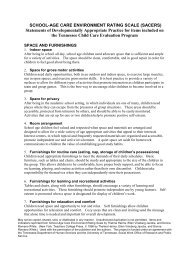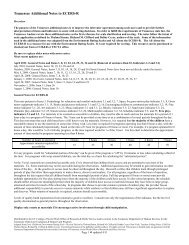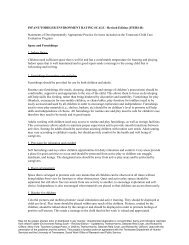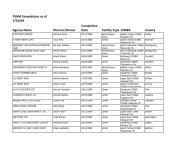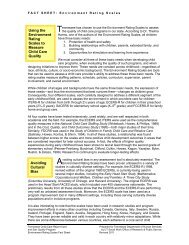ECERS-R - Star-Quality Program
ECERS-R - Star-Quality Program
ECERS-R - Star-Quality Program
Create successful ePaper yourself
Turn your PDF publications into a flip-book with our unique Google optimized e-Paper software.
EARLY CHILDHOOD ENVIRONMENT RATING SCALE – REVISED<br />
(<strong>ECERS</strong>-R)<br />
Statements of Developmentally Appropriate Practice<br />
SPACE AND FURNISHINGS<br />
1. Indoor space<br />
Children need sufficient space that is well lit and has a comfortable temperature for learning and<br />
playing. Indoor space that is well maintained and in good repair sends a message to the young child<br />
that is welcoming and inviting.<br />
2. Furniture for routine care, play and learning<br />
Children need appropriate furnishings to meet the demands of their daily schedules. Basic furniture<br />
such as cots, tables and chairs should be sturdy and appropriate to the size of the children in the group<br />
in order for children to be comfortable, have proper body support, and focus on learning, playing, and<br />
routine activities rather than their own discomfort. Caregivers need easy access to routine care<br />
furnishings, such as cots, in order to maintain proper supervision and provide smooth transitions<br />
between activities.<br />
3. Furnishings for relaxation and comfort<br />
Children need space and opportunity to relax and rest. Soft furnishings and toys allow children<br />
opportunities for relaxation and comfort. Cozy areas provide a space for quiet activities to occur and<br />
should be protected from active play so children can snuggle, daydream and lounge.<br />
4. Room arrangement<br />
Creative room arrangement promotes a child’s positive self-image and encourages a wide variety of<br />
age appropriate activities. Well-defined interest centers where materials are accessible help children to<br />
understand about organization and returning materials to their proper place.<br />
5. Space for privacy<br />
Some children experience unacceptably high levels of stress when exposed to constant activity and<br />
interaction. Places where children can escape from the pressures of group care promote positive<br />
self-esteem. Providing a child with opportunities, space, and time to be alone can contribute to<br />
positive classroom behavior.<br />
6. Child related display<br />
Every child needs to know that others value his/her play or work. Artwork or other individual work that<br />
is created by the children should be displayed in the classroom at the child’s eye-level. This promotes<br />
feelings of positive self-esteem and sends the message to the child that his/her work is valued and<br />
appreciated.<br />
May not be copied, shared, sold, or distributed in any manner. Unauthorized duplication is not permitted.<br />
Items and indicators reprinted from Early Childhood Environment Rating Scale – Revised Edition – Updated<br />
by Thelma Harms, Richard M. Clifford, and Debby Cryer. (New York: Teachers College Press, 2005 by<br />
Thelma Harms, Richard M. Clifford, and Debby Cryer.) Used with the permission of the publisher and the<br />
authors. This project is funded under an agreement with the Tennessee Department of Human Services<br />
and the University of Tennessee, Social Work Office of Research and Public Service.
7. Gross motor play<br />
Children need daily opportunities to exercise large muscles, run in open spaces, and practice gross<br />
motor skills. (Safety is always a number one priority.) Space to develop children’s large muscles<br />
through a variety of play experiences should be made safe by providing adequate cushioning for fall<br />
zones. All play equipment should be safe and effective monitoring should be implemented to teach<br />
children safe play behavior and to safeguard against accidents.<br />
8. Gross motor equipment<br />
Children need age appropriate stationary and portable equipment to promote a wide variety of skills<br />
that exercise large muscles while developing confidence and abilities. Equipment should be sound,<br />
sturdy, safe and accessible to children daily.<br />
PERSONAL CARE ROUTINES<br />
9. Greeting/Departing<br />
Parents and children need a warm, welcoming, and pleasant atmosphere to make the daily greeting and<br />
departing routine a happy one. Positive greetings help to promote the children’s self-esteem and<br />
create a welcoming environment for parents.<br />
10. Meals/Snacks<br />
Meals and snacks that follow USDA guidelines contribute to the health of children and provide a<br />
model for good nutritional habits for life-long practice. Proper hand washing along with careful food<br />
preparation teach children proper hygiene and promotes sanitary conditions.<br />
11. Nap/Rest<br />
Nap and/or rest time should be appropriately scheduled and supervised for the children in the group.<br />
Adequate separation of cots helps to prevent the spread of germs. Soft music or a soothing story helps<br />
to facilitate a peaceful rest time that is important in helping children to balance the day and renew their<br />
energy.<br />
12. Toileting/Diapering<br />
Young children need appropriate supervision of the toileting process in order to care for basic needs<br />
and to teach the importance of good health habits. The schedule should be individualized. Provisions,<br />
such as soap and steps near the sink, should be convenient and accessible so that children can wash<br />
hands after toileting; this promotes self-help skills and good personal hygiene. Diapering should<br />
always be managed in a manner that promotes safety and good health practices.<br />
May not be copied, shared, sold, or distributed in any manner. Unauthorized duplication is not permitted.<br />
Items and indicators reprinted from Early Childhood Environment Rating Scale – Revised Edition – Updated<br />
by Thelma Harms, Richard M. Clifford, and Debby Cryer. (New York: Teachers College Press, 2005 by<br />
Thelma Harms, Richard M. Clifford, and Debby Cryer.) Used with the permission of the publisher and the<br />
authors. This project is funded under an agreement with the Tennessee Department of Human Services<br />
and the University of Tennessee, Social Work Office of Research and Public Service.
13. Health practices<br />
Practicing preventive measures, such as washing hands after handling pets or wiping noses, help to<br />
educate children to achieve life-long health practices. Taking appropriate action when children are<br />
sick will minimize the spread of germs.<br />
14. Safety practices<br />
Protecting children is critical in providing quality care, whether through adequate supervision or<br />
minimizing hazards both inside and outside. Caregivers should anticipate potential safety problems<br />
and demonstrate, model, and teach children safe practices.<br />
Language-Reasoning<br />
15. Books and pictures<br />
The use of books and pictures is an important means of learning for children as they make sense of the<br />
world around them. Books, pictures, and language materials should be available in sufficient number<br />
both for independent use in a reading center and for use by a teacher with children in formal and<br />
informal settings.<br />
16. Encouraging children to communicate<br />
Activities and materials that promote language development should be available for use throughout the<br />
classroom and the daily schedule. Teachers should establish an environment where language<br />
exploration and usage is encouraged.<br />
17. Using language to develop reasoning skills<br />
Logical relationships and concepts should be presented in appropriate ways. Children learn through<br />
interaction with materials and people, both peers and adults, in the context of play and daily routines.<br />
Language provides the key tool for success and problem solving, as children are encouraged to talk<br />
through their thought processes.<br />
18. Informal use of language<br />
Language is a way for children to expand understanding. Caregivers should engage children in give<br />
and take conversations for enjoyment and learning. They should support child-to-child conversations<br />
as well.<br />
Activities<br />
19. Fine motor<br />
Children need a variety of age-appropriate and developmentally-appropriate toys and materials that<br />
they can manipulate with their hands and play with at will. These activities strengthen fine motor<br />
control while encouraging skill development that contributes to academic readiness.<br />
May not be copied, shared, sold, or distributed in any manner. Unauthorized duplication is not permitted.<br />
Items and indicators reprinted from Early Childhood Environment Rating Scale – Revised Edition – Updated<br />
by Thelma Harms, Richard M. Clifford, and Debby Cryer. (New York: Teachers College Press, 2005 by<br />
Thelma Harms, Richard M. Clifford, and Debby Cryer.) Used with the permission of the publisher and the<br />
authors. This project is funded under an agreement with the Tennessee Department of Human Services<br />
and the University of Tennessee, Social Work Office of Research and Public Service.
20. Art<br />
Children benefit from exposure to child-initiated art activities that are open-ended and process<br />
oriented. Children’s art should be respected and appreciated as individual, creative expression.<br />
Materials and opportunities to create art projects at a beginning and more advanced level should be<br />
available as children are developmentally ready for them.<br />
21. Music/movement<br />
Music and movement are valuable means of learning. Children need a supportive environment that<br />
includes a teacher and a variety of tools to encourage their self-expression through music and related<br />
activities.<br />
22. Blocks<br />
Block play, with a variety of blocks and accessories, allows children the opportunity to explore spatial,<br />
mathematical, and role-play possibilities. Powerful block play requires sufficient space in a protected<br />
area and time to expand on concepts and ideas.<br />
23. Sand/water<br />
Sand and water play gives children the opportunity to learn concepts through active exploration with<br />
their senses. The addition of interesting props extends the learning potential offered through sensory<br />
play.<br />
24. Dramatic play<br />
Dramatic play gives children the opportunity to discover an array of roles and responsibilities. It<br />
provides a vehicle through which they make sense of their world. Dramatic play is enhanced by<br />
space, time, props, materials, and supportive teachers.<br />
25. Nature/science<br />
Science and nature activities and materials foster curiosity and experimentation benefiting the young<br />
learner through direct experience and application to other areas of learning. Concept and observation<br />
skills are strengthened through science procedures.<br />
26. Math/number<br />
Math skills, when introduced through appropriate hands-on methods, form a foundation for school<br />
readiness and later academic success. Math skills can be taught effectively through routines,<br />
schedule, and play activities.<br />
27. Use of TV, video, and/or computer<br />
TV/video viewing and computer use tend to be passive in comparison to active involvement with<br />
materials and people. The use of each should be confined to subject material that is age-appropriate<br />
and mentally stimulating. Time limits encourage more active learning. Participation should not be<br />
required.<br />
28. Promoting acceptance of diversity<br />
Children need to be exposed to the similarities and differences of people in positive ways through<br />
books, pictures, toys, materials, and interaction. This exposure encourages respect for others and<br />
lessens misunderstandings.<br />
May not be copied, shared, sold, or distributed in any manner. Unauthorized duplication is not permitted.<br />
Items and indicators reprinted from Early Childhood Environment Rating Scale – Revised Edition – Updated<br />
by Thelma Harms, Richard M. Clifford, and Debby Cryer. (New York: Teachers College Press, 2005 by<br />
Thelma Harms, Richard M. Clifford, and Debby Cryer.) Used with the permission of the publisher and the<br />
authors. This project is funded under an agreement with the Tennessee Department of Human Services<br />
and the University of Tennessee, Social Work Office of Research and Public Service.
INTERACTIONS<br />
29. Supervision of gross motor activities<br />
Caregivers should use gross motor activities as learning opportunities to promote positive social<br />
interactions and to encourage the development of skills and new experiences Diligent supervision of<br />
gross motor activities, whether indoors or outdoors, is critical to preventing accidents and insuring<br />
safe, active play.<br />
30. General supervision of children (other than gross motor)<br />
During activities, caregivers must balance the level of supervision and control based upon the ages,<br />
abilities, and individual needs of the children. Adequate supervision and awareness of the whole<br />
group is required for children’s health and safety and in the recognition of accomplishments, which is<br />
necessary for children’s emotional well-being.<br />
31. Discipline<br />
The set-up of the environment, teacher expectations, available materials and opportunities, and daily<br />
schedule significantly impacts children’s behavior in childcare. A classroom and curriculum geared<br />
toward developmentally appropriate practice will lead to generally good behavior that is the product of<br />
self-motivation rather than the result of punishment and control.<br />
32. Staff-child interactions<br />
Caregivers, who are nurturing and responsive, promote the development of mutual respect between<br />
children and adults. Children, who trust adults to provide for their physical, psychological, and<br />
emotional needs, develop their own sense of self-worth and self-esteem.<br />
33. Interactions among children<br />
Because self-regulation, proper emotional expression, and positive social relationships are such<br />
essential skills for later schooling and life, teachers must encourage children to develop acceptable<br />
behaviors by providing a setting that encourages real opportunities for initiative taking and<br />
competence building. Providing opportunities for children to work and play together, to solve<br />
conflicts in productive ways, and to participate in group activities are ways teachers promote positive<br />
social relationships.<br />
PROGRAM STRUCTURE<br />
34. Schedule<br />
Children thrive on having a consistent routine that provides a balance of activities designed to meet<br />
individual needs and foster physical, cognitive, social, and emotional growth. Best practice promotes<br />
a daily schedule with large amounts of time for play, smooth transitions between activities, and a<br />
balance between child-initiated and teacher-directed activities.<br />
May not be copied, shared, sold, or distributed in any manner. Unauthorized duplication is not permitted.<br />
Items and indicators reprinted from Early Childhood Environment Rating Scale – Revised Edition – Updated<br />
by Thelma Harms, Richard M. Clifford, and Debby Cryer. (New York: Teachers College Press, 2005 by<br />
Thelma Harms, Richard M. Clifford, and Debby Cryer.) Used with the permission of the publisher and the<br />
authors. This project is funded under an agreement with the Tennessee Department of Human Services<br />
and the University of Tennessee, Social Work Office of Research and Public Service.
35. Free Play<br />
When children are permitted to select materials and companions, and, as far as possible, manage play<br />
independently, they practice making decisions and having control of their world. Caregiver<br />
intervention should be in response to children’s needs, an invitation, or an opportunity to expand play<br />
activities.<br />
36. Group Time<br />
In group-care situations, the focus needs to be on meeting individual needs and guiding children as<br />
they interact in small groups. Whole group activities should be kept to a minimum and limited to<br />
gatherings that follow the interests and involvement of the children.<br />
37. Provisions for children with disabilities<br />
Meeting the needs of children with disabilities requires knowledge of routine care needs,<br />
developmental levels, individual assessments, and the integration of the children in ongoing classroom<br />
activities. It also requires the involvement and establishment of a partnership between the parents and<br />
staff in setting attainable goals that will assist the child in reaching his/her full potential.<br />
May not be copied, shared, sold, or distributed in any manner. Unauthorized duplication is not permitted.<br />
Items and indicators reprinted from Early Childhood Environment Rating Scale – Revised Edition – Updated<br />
by Thelma Harms, Richard M. Clifford, and Debby Cryer. (New York: Teachers College Press, 2005 by<br />
Thelma Harms, Richard M. Clifford, and Debby Cryer.) Used with the permission of the publisher and the<br />
authors. This project is funded under an agreement with the Tennessee Department of Human Services<br />
and the University of Tennessee, Social Work Office of Research and Public Service.




